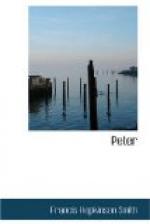It was at this time that the new church to be built at Corklesville needed an architect—a fact which Jack communicated to Garry. Then it happened that with the aid of MacFarlane and Holker Morris the commission was finally awarded to that “rising young genius who had so justly distinguished himself in the atelier of America’s greatest architect—Holker Morris—” all of which Garry wrote himself and had inserted in the county paper, he having called upon the editor for that very purpose. This service —and it came at a most critical time in the young man’s affairs— the Scribe is glad to say, Garry, with his old-time generous spirit suddenly revived, graciously acknowledged thanking Jack heartily and with meaning in his voice, as well as MacFarlane—not forgetting Ruth, to whom he sent a mass of roses as big as a bandbox.
The gaining of this church building—the largest and most important given the young architect since he had left Morris’s protection and guidance—decided Garry to give up at once his expensive quarters in New York and move to Corklesville. So far as any help from the house of Breen was concerned, all hope had ended with the expensive and much-advertised wedding (a shrewd financial move, really, for a firm selling shady securities). Corinne had cooed, wept, and then succumbed into an illness, but Breen had only replied: “No, let ’em paddle their own canoe.”
This is why the sign “To Let,” on one of the new houses built by the Elm Crest Land and Improvement Company—old Tom Corkle who owned the market garden farms that gave the village of Corklesville its name, would have laughed himself sore had he been alive—was ripped off and various teams loaded with all sorts of furniture, some very expensive and showy and some quite the contrary—especially that belonging to the servants’ rooms—were backed up to the newly finished porch with its second coat of paint still wet, and their contents duly distributed upstairs and downstairs and in my lady Corinne’s chamber.
“Got to put on the brakes, old man,” Garry had said one day to Jack. The boy had heard of the expected change in the architect’s finances before the villa was rented, and so Garry’s confidential communication was not news to him.
“Been up to look at one of those new houses. Regular bird cage, but we can get along. Besides, this town is going to grow and I’m going to help it along. They are all dead out here—embalmed, some of them—but dead.” Here he opened the pamphlet of the company— “See this house—an hour from New York; high ground; view of the harbor—(all a lie, Jack, but it goes all the same); sewers, running water, gas (lot of the last,—most of it in the prospectus) It’s called Elm Crest—beautiful, isn’t it,—and not a stump within half a mile.”
Jack always remembered the interview. That Garry should help along anything that he took an interest in was quite in the line of his ambition and ability. Minott was as “smart as a steel trap,” Holker Morris had always said of him, “and a wonderful fellow among the men. He can get anything out of them; he would really make a good politician. His handling of the Corn Exchange showed that.”




